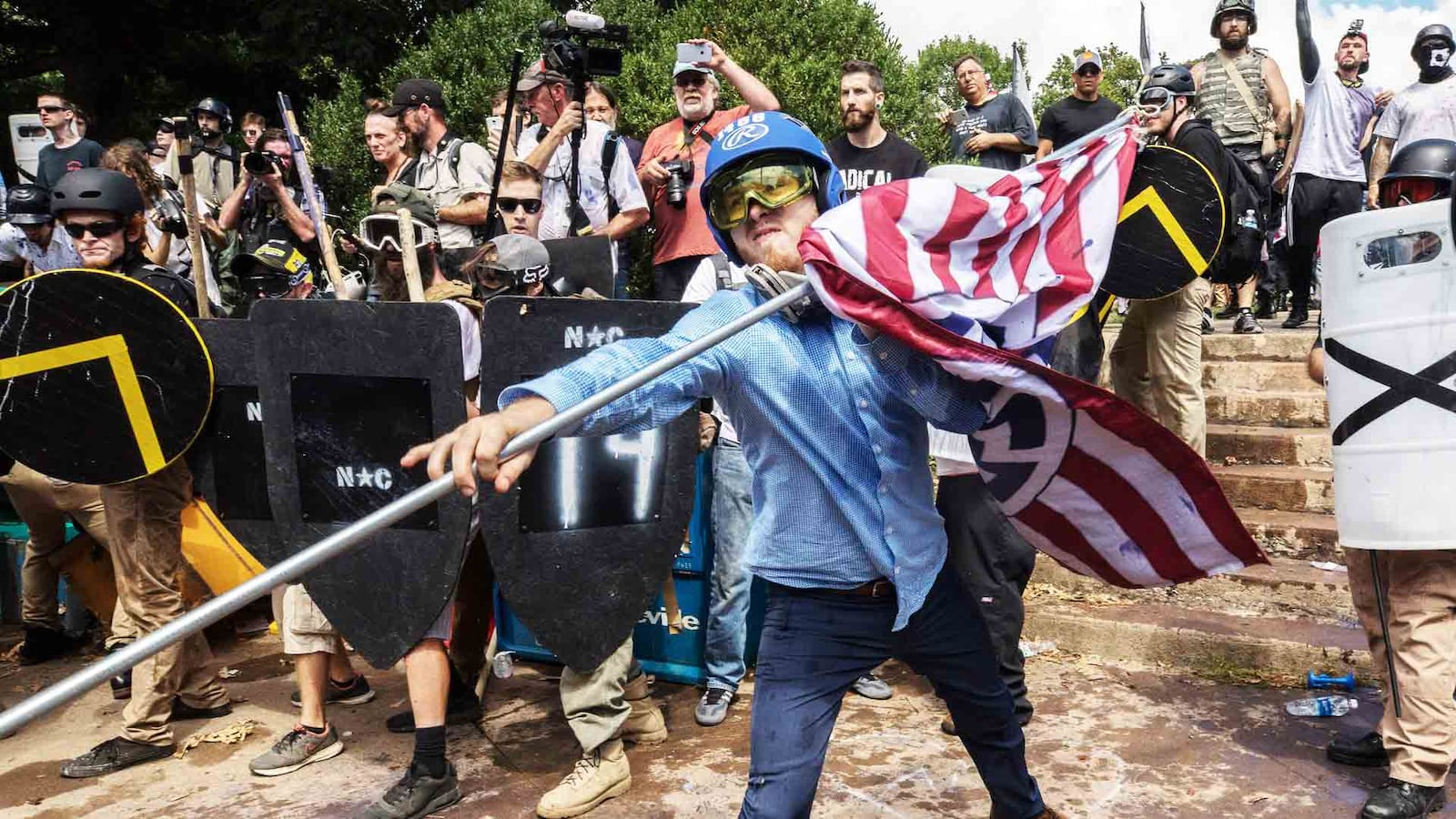To many on the right—especially Donald Trump loyalists and devotees of white nationalist YouTube personalities—the black-clad anarchists known as Antifa represent the coming of a Stalinist dictatorship. To a sizable portion of the political left and center, the sight of tiki torch-wielding white supremacists marching through Charlottesville, Virginia earlier this month portends a future of Nuremberg rallies and the death of liberal democracy.
The state of many Americans’ heightened anxiety is understandable. The presidency of Donald Trump has been a chaotic fiasco by any reasonable metric, and the instability of the commander-in-chief has made us all a bit edgier than usual.
Following up a week of possible accidental nuclear apocalypse with images of brazen neo-Nazis chanting phrases such as “Jews will not replace us” and the English translation of the German Nazi slogan “blood and soil,” topped off with a cowardly terrorist attack by one of the alt-right losers in attendance, Americans looked to their president for reassurance. Instead, they were met with equivocation.
Members of the president’s party—including Rep. Steve Scalise, who was nearly assassinated in June by an unhinged Bernie Sanders supporter—unreservedly condemned the violence initiated by the alt-rightist who intentionally drove his car into an assembly of peaceful protesters. Such full-throated condemnation wasn’t a particularly brave act. Slagging Nazis is about the easiest political layup available to any politician anywhere. Yet, it was too much for Trump, because the alt-right sympathizers in his inner circle have him fixated on antifa—who, while present in Charlottesville, represented only a portion of the counter-protest.
To be very clear, antifa and neo-Nazis do not reside on the same moral plane; white supremacists are demonstrably worse in both word and deed. Still, antifa wears its violence as a badge of courage, a necessary response to fascism that (in their view) liberals who believe in the necessity of civil liberties lack the courage to effectively confront. Antifa’s incoherent ideology was aptly summarized by one 20-year-old participant, recently quoted in The New York Times: “You need violence in order to protect nonviolence.” They want to make the world safe from Nazis by making them feel unsafe. Given the increasing willingness of neo-Nazis to march—unmasked and in public—it’s safe to say antifa’s tactics haven’t worked.
But that hasn’t prevented a healthy amount of antifa self-mythologizing, particularly in a number of pieces for The Nation by journalist and part-time masked vigilante Natasha Lennard, who has extolled the “pure kinetic beauty” of one of her cohort decking the unsuspecting (and odious) alt-right leader Richard Spencer. A more recent piece features Lennard engaging in delusions of tragic revolutionary grandeur by comparing today’s antifa with the anti-fascists who fought (and lost) in street battles against government-supported gangs in Nazi Germany and fascist Spain and Italy.
I enjoy seeing Nazis punched as much as the next decent human being, but I still maintain that violence is wrong and is a failure of political thought, not a righteous tool of it. In the aftermath of Inauguration Day’s viral Spencer-punching, it was more than a little disconcerting to see so many people who heretofore were proponents of the rule of law cheering on antifa as the self-deputized arbiters of acceptable political violence. While social media flooded with images of Indiana Jones and Superman and Captain America punching Nazis, I wondered if the terms “Nazi” or “fascist” might come to lose their meaning when deployed by antifa in search of the thrill of a fight.
A more sober analysis of how to deal with the new Nazi threat was penned by the leftist writer Amber A'Lee Frost in Current Affairs, where she argued that it’s “hazardous (and intellectually dishonest)” to treat “Nazis as some massive unstoppable movement on the precipice of seizing power (which they are not). Exaggerating the power and influence of the Alt-Right not only contributes to unnecessary panic, it plays into their promotion campaigns.”
It bears repeating that unlike neo-Nazis, neo-antifa haven’t killed anyone, and according to a study by Alex Nowrasteh of the Cato Institute, the levels of deadly violence committed by the far-right dwarfs their left-wing counterparts by a factor of 10 over the past 25 years.
However, the notion that antifa participants have kept their violence strictly “anti-fascist” is plainly untrue, as most recently evidenced in the assaults on two journalists (including a woman, Taylor Lorenz of The Hill) in Charlottesville. In the aftermath of the violence, a defiant post on Antifa Seven Hills’ Facebook page blamed the reporters for the attacks they endured at the hands of the masked “anti-fascists.”
The post read in part:
Media you do not have the right to treat us this way. We are not your spectacle to profit off of. You are very often disrespectful and aggressive and we you [sic] will be met with the same behavior. If you don’t want to get hit don’t act like vultures. Ask for consent.
How the Nazi punchers have fallen.
No less an authority on leftist radicalism than Noam Chomsky has called antifa “a major gift to the right.” The legendary linguist and author added in an interview with the Washington Examiner, “what they do is often wrong in principle—like blocking talks—and [the movement] is generally self-destructive.”
While not in any way equals in terms of malevolent intent and action, the emergence of both antifa and the alt-right as cultural figureheads of menace is emblematic of the current political moment of perpetual crisis. However, we would be wise to take a deep breath and think of these infinitesimally small factions as what they are, and not make them into something larger.
They are not revolutionaries, and they are not the beating hearts of “red America” and “blue America.” They are pathetic LARPers (Live Action Role Players), violent intolerant clowns, and nihilistic opportunists taking advantage of societal anxieties to live out fantasies of bloody heroism on the public stage.
Violence should be disturbing to any civil society, but we should not overstate the threat of political violence by antifa or white supremacists. These groups are symptomatic of a sickness addling the United States, but they are not the disease itself.






